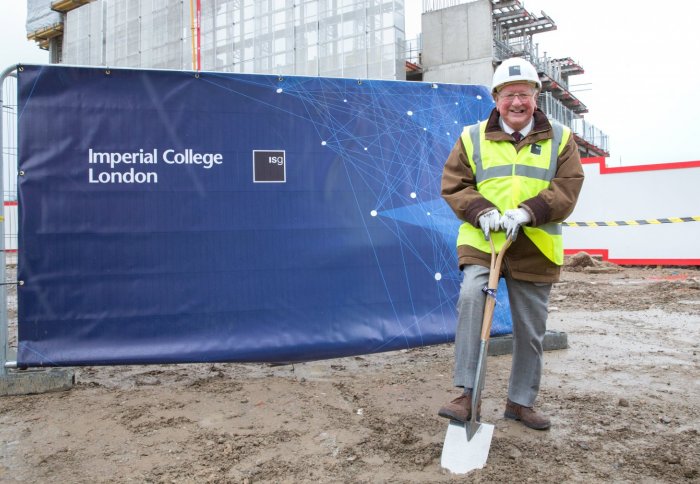Imperial breaks new ground with visionary medical research facility

Sir Michael Uren at the site
Imperial has started construction works for a pioneering research facility, the Michael Uren Biomedical Engineering Research Hub at White City.
The hub will help find solutions to some of the most pressing biomedical and healthcare problems of our time. By bringing together Imperial’s world-leading researchers, engineers, scientists and clinicians, it will support work on life-changing research into new and affordable medical technology.
The Michael Uren Biomedical Engineering Research Hub... will take our existing success in biomedical engineering to a scale and a level that will bring real health benefits to individuals and society
– Professor Jeff Magee
Dean of the Faculty of Engineering
The launch of construction works for the new facility was marked with a groundbreaking ceremony at the White City Campus on Monday 9 January. The event was attended by Imperial alumnus Sir Michael Uren OBE and trustees of his foundation, whose £40 million gift has made the construction of the new hub possible. The donation is the largest ever made to a London university by an alumnus, and one of the largest in the history of any UK higher education institution.
Speaking at the milestone event, Sir Michael said: “Imperial College London is an inspirational place. I was inspired when I joined in September 1940 and I am inspired here today.
“My vision is that in building this research centre a few miles from the City of London – which itself has become a financial centre of the world – investment will be watching and waiting for the research and inventions that will be developed here, which will trigger tomorrow’s great companies.”
Imperial College London’s President, Alice Gast, commented on the facility’s significance: “This is a day to celebrate not only putting shovels in the ground, but a change in direction and a position of leadership in bringing engineering, medicine, science and technology together to address the healthcare challenges of this century.
“We owe this position of leadership to Sir Michael’s vision, generosity and foresight. He is making history by bringing researchers and clinicians together to collaborate on research, technology development and clinical application at an excellent university that is so adept at multidisciplinary collaboration.”
Research areas for the Michael Uren Biomedical Engineering Research Hub will include new technologies for the early detection, monitoring and treatment of cancers; the development of minimally invasive implants; regenerative medicine and technology to aid recovery from nervous system injuries.
Professor Jeff Magee, Dean of the Faculty of Engineering at Imperial College, said: “Biomedical engineering brings engineered, technological solutions to a wide range of medical challenges – from prosthetics for soldiers injured in bomb blasts that move naturally and are sensitive to touch, to creating bioactive materials that stimulate the body to heal itself. The Michael Uren Biomedical Engineering Research Hub will be critical in enabling researchers at Imperial to create this future and will take our existing success in biomedical engineering to a scale and a level that will bring real health benefits to individuals and society.”
Construction work for the Michael Uren Biomedical Engineering Research Hub is scheduled for completion in 2019. The biomedical engineering hub, which was recently awarded £20m of government funding by the Higher Education Funding Council for England (HEFCE) through the UK Research Partnership Investment Fund (UK RPIF), will be the first and largest facility to occupy the building. A clinical facility will also be incorporated within the building side-by-side with multidisciplinary laboratories and offices for translational research initiatives, providing patients with direct access to the latest innovations in healthcare.
Article text (excluding photos or graphics) © Imperial College London.
Photos and graphics subject to third party copyright used with permission or © Imperial College London.
Reporter
John-Paul Jones
Communications and Public Affairs